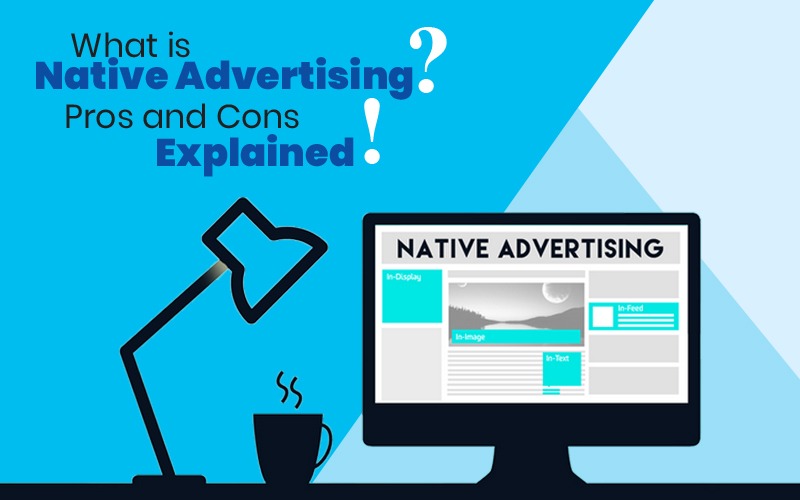What is native advertising?
Native advertising is a type of sponsored media that is intended to fit in perfectly with the platform’s content. Native advertising, as opposed to traditional advertising, offers a non-disruptive user experience by assimilating the platform’s appearance, feel, and operation. It is frequently used in blogs, social media, and online publications to interact with readers while discreetly advertising a good or service.
By producing value-driven content that meets audience expectations, native advertising enables brands to gain trust. Businesses can more successfully integrate native advertising into their marketing plans for improved audience engagement and results by being aware of its characteristics.
While curating the right digital marketing strategy for any business, some techniques like native advertising are hard to miss even for the marketers. It’s another clever digital marketing tactic that drives the attention of the target audience to a specific type of content made by the brand.
Native Advertising
Native advertising is a non-disruptive sort of advertising that matches the content and feel of the source site without giving an expression of sponsored content. It is a paid form of advertising that can be used on social media, search engines, and the open web. Native ads match the surrounding content and offer 8.8 times higher click-through rates and boost conversions.
Among the many benefits of local advertising are enhanced user experience and higher engagement. local advertisements feel less invasive since they blend in with the platform’s aesthetic, which increases click-through rates and conversions. Furthermore, local advertising helps companies establish genuine connections with consumers, which promotes authenticity and trust.
It does, however, have certain disadvantages. Badly done local advertisements have the ability to harm a brand’s reputation by confusing users or making it difficult to distinguish between advertising and content. In addition, native advertising frequently costs more than traditional display ads and necessitates careful planning. Successfully utilizing native advertising requires striking a balance between these benefits and drawbacks.
It is sponsored advertising that tends to show up as organic content in front of the viewers in a source that is chosen by them. Native advertising tends to have more engagement rates than traditional advertising because it has a natural and intuitive approach to a user’s regular media consumption.
Pros:
The advantages of native advertising are
- Create Brand Awareness:
Native advertising is a great source to create brand awareness on channels like social media, websites, and search engines. Brands can use native advertising to increase awareness about them and reach the maximum audience with an organic appeal.
- Grabs Viewer’s Attention:
Even if the ad does not look like sponsored content, brands can still get the attention of their desired audience by creating powerful and eye-catching content. It’s a great technique to target the customers on such a platform where they have come themselves. User-generated content that is relevant to the function and nature of the source can grab the attention of viewers easily.
- Doesn’t Disturb the Users:
Unlike banner ads, native ads are non-disruptive and do not interrupt the users natural scrolling on the source of their interest. Disruptive ads usually annoy the viewers, and they block them instantly. Showing ads to the viewers without making them realize it’s an ad is a clever tactic that every marketer should use.
Cons:
Following are some of the disadvantages of native advertising:
- Complex Impact Measuring:
It is complicated to analyze and measure the performance, impact, and sustainability of native advertising. Advertisers may find it complicated to evaluate the return on investment (ROI) of this type of advertising.
- Time and Effort Consuming:
Although native ads have a higher engagement rate than traditional advertising, it is time-consuming to produce an ad that seems relevant to the feel of the source, be it any website, article, social media, or search engine. Native advertising takes a lot of time and effort from the content creators, copywriters, designers, and advertisers.
- Deception:
Users want an uninterruptable experience while navigating through a website and search engine. Native ads can provide this experience to the viewers by creating a seamless transition between paid and organic content. But an ad must look like an ad and should not deceive the customers. To cope with this concern, advertisers are advised to write words like Ad, Paid, and Sponsored somewhere near the content.
For contemporary marketers, advertising is an effective technique because it provides a distinctive method of audience engagement without interfering with their browsing experience. Native advertising increases brand awareness, fosters trust, and promotes meaningful interactions when done well.
Businesses must, however, continue to be aware of its difficulties, such as the requirement for transparent and high-quality material to prevent deceiving customers. Native advertising will be essential to establishing connections between brands and consumers as digital platforms develop further. Businesses can integrate native advertising into their strategies to create sustainable growth and strengthen consumer connections by being aware of its possibilities and potential drawbacks.
Author: Areej Waseem
